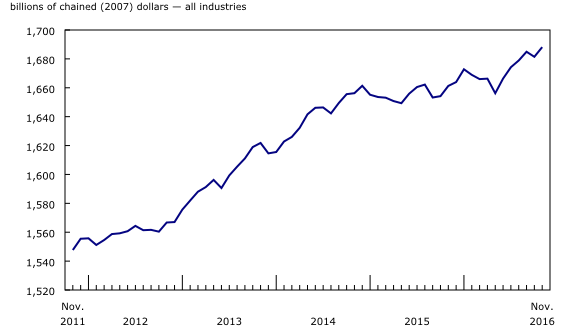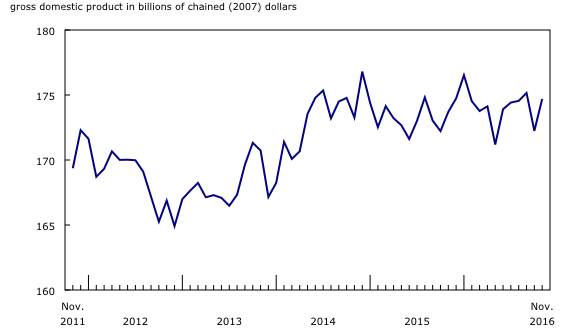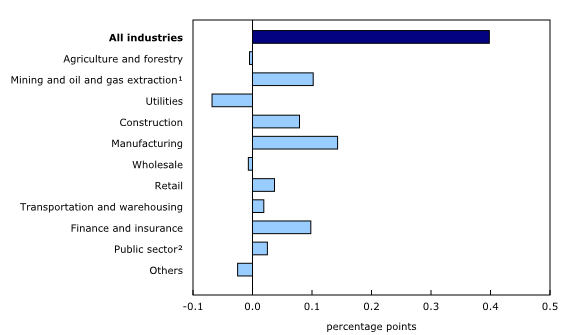Gross domestic product by industry, November 2016
Archived Content
Information identified as archived is provided for reference, research or recordkeeping purposes. It is not subject to the Government of Canada Web Standards and has not been altered or updated since it was archived. Please "contact us" to request a format other than those available.
Released: 2017-01-31
November 2016
0.4% 
(monthly change)
Real gross domestic product rose for the fifth time in six months, up 0.4% in November. The increase in November came mainly from higher output in manufacturing, mining, quarrying, and oil and gas extraction, finance and insurance and construction.
Goods-producing industries rose by 0.9%, almost offsetting a 1.0% decline in October. There were increases in output in manufacturing, mining, quarrying, and oil and gas extraction and construction. The utilities and the agriculture and forestry sectors declined.
Service-producing industries were up 0.2%, mainly due to finance and insurance, retail trade, and transportation and warehousing. There was a decline in real estate and rental and leasing, while wholesale trade edged down.
Manufacturing sector grows in November
Manufacturing grew 1.4% in November following a 1.7% decline in October. With the exception of October, output in the manufacturing sector has risen every month since June.
Non-durable manufacturing grew 1.5%, led by a 3.6% gain in the output of chemical manufacturers. Petroleum and coal products manufacturing increased following three consecutive declines, which were linked to partial shutdowns for maintenance and retooling work. Food manufacturers had higher output for the fourth time in five months.
Durable manufacturing rose 1.3%, with the largest contributions coming from manufacturers of machinery, computer and electronic products and primary metals. There were declines in fabricated metal product, transportation equipment and miscellaneous manufacturing.
Mining, quarrying, and oil and gas extraction expands
The output of the mining, quarrying, and oil and gas extraction expanded 1.4% in November. Oil and gas extraction rose 1.3%, as non-conventional oil extraction grew 3.7%, partly due to increased production capacity. Conventional oil and gas extraction contracted 0.9%.
Mining excluding oil and gas extraction increased 2.9%. Metal ore (such as iron ore) and potash led the growth, driven in part by higher exports.
Support activities for mining and oil and gas contracted 1.9% as rigging services declined.
Finance and insurance increase
Finance and insurance was up 1.5% in November, the largest increase since December 2014. Banking and financial investment services were up in large part due to higher investment revenues, as financial market activity in November was stronger than usual.
Construction up
The construction sector rose 1.1% in November. This was the second increase in three months, after mostly decreasing since the fourth quarter of 2014 mainly due to declines in non-residential construction.
Residential construction (+2.0%) was the major contributor to the November increase, mainly due to work related to alterations and improvements. Repair construction rose 2.8%, the highest growth rate since the beginning of the series in 2007. Non-residential construction declined 0.4%.
Retail trade grows while wholesale trade edges down
Retail trade was up 0.7% as the majority of subsectors increased, led by motor vehicle and parts dealers, building material and garden equipment and supplies dealers, and furniture and home furnishings stores.
Wholesale trade edged down 0.1% in November, led by declines at motor vehicle and parts wholesalers, partly as a result of lower exports and imports. Output by wholesalers of food, beverage and tobacco and personal and household goods was also down. Increases were registered by building material and supplies and miscellaneous wholesalers.
Transportation and warehousing services increase
Transportation and warehousing services were up 0.4% as the majority of the subsectors grew. There was more activity at postal services and couriers and messengers, which are both used to deliver goods purchased from electronic commerce sites. Rail transportation was up 0.6% in November, as movement of coal and intermodal freight increased. Pipeline transportation rose 0.2%, as increased crude oil transportation more than offset lower demand for natural gas.
Utilities down as a result of warmer weather in Western Canada
Utilities (-3.0%) declined for the third consecutive month and had the largest negative impact on real GDP in November. Natural gas distribution as well as electric power generation, transmission and distribution were down due to unseasonably warm weather across the western part of the country.
Real estate sector declines
The real estate and rental and leasing sector declined 0.2% in November, the first monthly decline since May 2012. Real estate agents and broker activities decreased 6.2% in November, following lending rule changes that came into effect in mid-October.
This reduced activity in real estate also had an impact on legal services, which declined 2.6%.
Other industries
The public sector (education, health and public administration) edged up 0.1% in November. Educational services and health care and social assistance rose while public administration was essentially unchanged.
Accommodation and food services were flat as growth in food services and drinking places was offset by declines in accommodation services.
Arts, entertainment and recreation edged down 0.1% in November, primarily due to a decline in spectator sports and related industries.
A historical perspective on gross domestic product by industry
As 2017 marks the 150th anniversary of Confederation, we take a look back at the history of GDP as a means to examine the Canadian economy.
The first release of monthly economic output in terms of real GDP by industry in its present format (with GDP values at basic prices) was for reference months July and August 1981. In the original release, the level of economic activity in Canada fell in both July (-1.4%) and August (-0.5%).
Factors influencing the declines in July and August 1981 included work stoppages involving some 60,000 employees in the forestry, pulp and paper and wood products industries in British Columbia, and a six-week strike by 23,000 inside workers at Canada Post throughout July and part of August.
The make-up of the Canadian economy from a GDP by industry perspective has changed significantly since 1981. The forestry and logging sector accounted for approximately 1% of the Canadian economy in 1981, while today it represents about 0.2%.
Note to readers
Monthly gross domestic product (GDP) by industry data at basic prices are chained volume estimates with 2007 as the reference year. This means that data for each industry and each aggregate are obtained from a chained volume index, multiplied by the industry's value added in 2007. Monthly data are benchmarked to annually chained Fisher volume indexes of GDP obtained from the constant-price supply and use tables (SUT) up to the latest SUT year (2013).
For the period starting with January 2014, data are derived by chaining a fixed-weight Laspeyres volume index to the prior period. The fixed weights are 2013 industry prices.
This approach makes the monthly GDP by industry data more comparable with expenditure-based GDP data, which are chained quarterly.
All data in this release are seasonally adjusted. For information on seasonal adjustment, see Seasonally adjusted data – Frequently asked questions.
For more information on GDP, see the video "What is Gross Domestic Product (GDP)?"
Revisions
With this release of monthly GDP by industry, revisions have been made back to January 2016.
Each month, newly available administrative and survey data from various industries in the economy are integrated and result in statistical revisions. Updated and revised administrative data (including taxation statistics), new information provided by respondents to industry surveys, and standard changes to seasonal adjustment calculations are incorporated with each release.
For more information about monthly national GDP by industry, see the System of Macroeconomic Accounts module on our website.
Real-time CANSIM tables
Real-time CANSIM table 379-8031 will be updated on February 9. For more information, consult the document Real-time CANSIM tables.
Next release
Data on GDP by industry for December 2016 will be released on March 2, 2017.
Contact information
For more information, contact us (toll-free 1-800-263-1136; 514-283-8300; STATCAN.infostats-infostats.STATCAN@canada.ca).
To enquire about the concepts, methods or data quality of this release, contact Allan Tomas (613-790-6570), Industry Accounts Division.
- Date modified:




